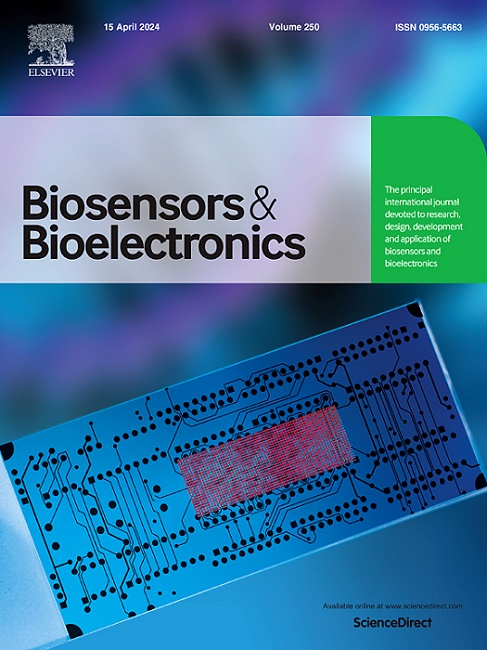Two Birds with One Stone: Fe-DNA nanospheres produced via coordination-propelled self-assembly with excellent peroxidase-like property for versatile ratiometric fluorescent assay and cellular imaging
IF 10.7
1区 生物学
Q1 BIOPHYSICS
引用次数: 0
Abstract
Exploring novel versatile nanozymes for multi-signal biosensing and cellular application is one of the most promising directions to meet the diversified requirements in this field. Herein, by harnessing coordination-propelled self-assembly between Fe (II) and DNAs, we prepared Fe-DNA nanospheres (Fe-DNA NSs) via a cost-effective one-step hydrothermal method, and pioneered the application of its excellent POD-mimicking property to fluorescent substrates. Initially, we investigated its enzyme-like activity using TMB as canonical colorimetric substrate and screened its catalytic oxidation effects towards different fluorescent substrates, such as T-HCl, AR, OPD and Sc, respectively. Afterwards, by virtue of the contrary fluorescent changes of Sc (decreased FI465) and OPD (increased FI562) and the cooperative effects of FRET/IFE between them, we devised the first universal Fe-DNA nanospheres-based ratiometric fluorescent (RF) platform. Taking H2O2 and glucose as model targets, two RF biosensors based on the alternative direct-nanozyme-catalysis and enzyme/nanozyme-tandem-catalysis were rationally fabricated, respectively. And we further exploited them to evaluate the quality of commercial contact lens care solution, and sensitively determine the blood glucose level of human. Moreover, corresponding cytotoxicity experiments adequately proved the superior biocompatibility of Fe-DNA NSs over most inorganic nanozymes. Furthermore, taking Cy5-labelled A20 strands as templates, we synthesized small-sized (∼60 nm) Fe-DNA fluorescent nanozyme and achieved efficient cellular delivery/imaging. This work not only offered a valid prototype for operating multi-signal-responsive nanozymatic biosensors, but also opened unique avenues for the bio-applications of nucleic acids-originated fluorescent nanozymes in cellular imaging and biotherapy.
求助全文
约1分钟内获得全文
求助全文
来源期刊

Biosensors and Bioelectronics
工程技术-电化学
CiteScore
20.80
自引率
7.10%
发文量
1006
审稿时长
29 days
期刊介绍:
Biosensors & Bioelectronics, along with its open access companion journal Biosensors & Bioelectronics: X, is the leading international publication in the field of biosensors and bioelectronics. It covers research, design, development, and application of biosensors, which are analytical devices incorporating biological materials with physicochemical transducers. These devices, including sensors, DNA chips, electronic noses, and lab-on-a-chip, produce digital signals proportional to specific analytes. Examples include immunosensors and enzyme-based biosensors, applied in various fields such as medicine, environmental monitoring, and food industry. The journal also focuses on molecular and supramolecular structures for enhancing device performance.
 求助内容:
求助内容: 应助结果提醒方式:
应助结果提醒方式:


